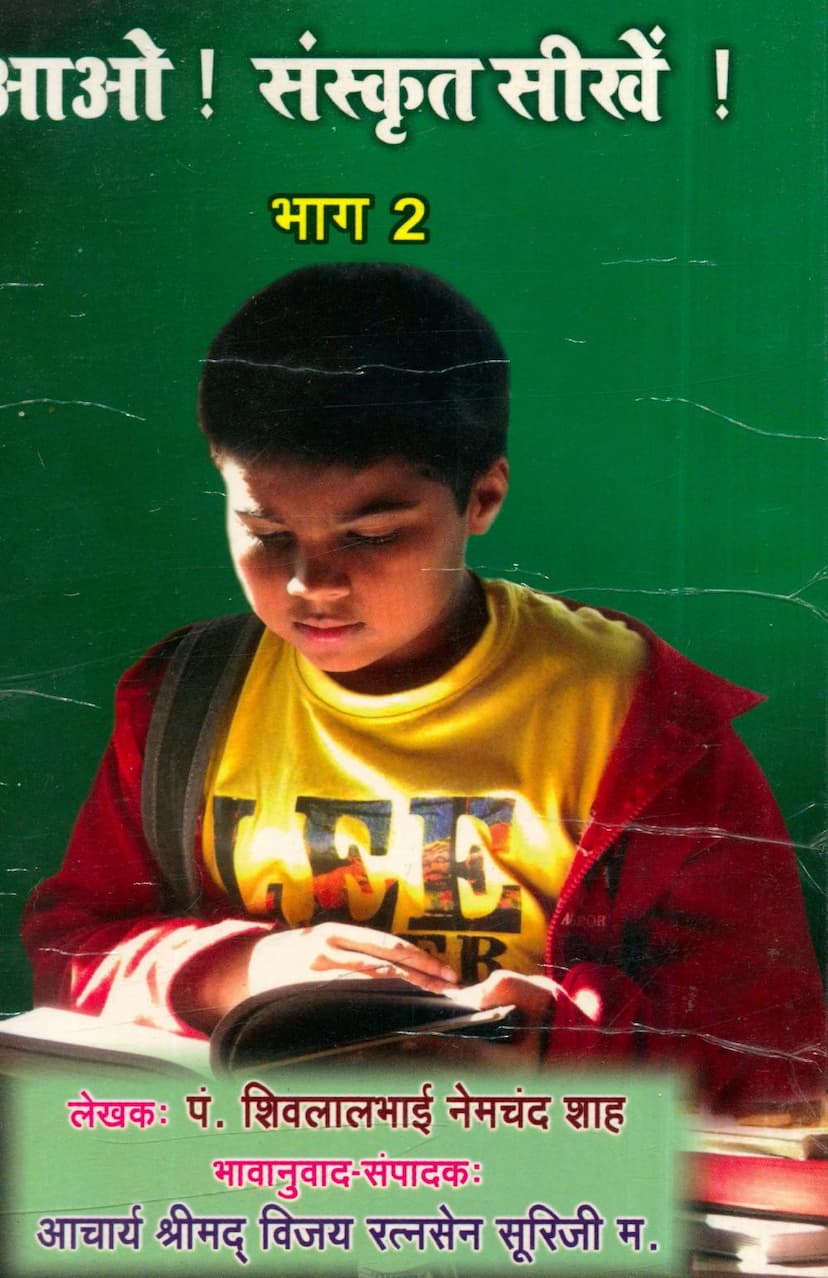Aao Sanskrit Sikhe Part 02
Added to library: September 1, 2025

Summary
The text provided is "Aao Sanskrit Sikhe Part 02" (Let's Learn Sanskrit Part 2) by Pandit Shivlal Nemchand Shah, with a Hindi translation and editing by Acharya Shrimad Vijay Ratnasensuri. It is a Jain text published by Divya Sandesh Prakashan.
The book is presented as a part of a series aimed at teaching Sanskrit, particularly for those interested in Jain religious literature. The preface and the author's note highlight the importance of Sanskrit and Prakrit languages for understanding the profound secrets of Jain philosophy and scriptures. The text emphasizes the declining state of Sanskrit learning in the current era and the author's and editor's dedication to reviving its study within the Jain community.
The book itself is a comprehensive grammar guide, detailing the various aspects of Sanskrit language learning. It covers:
- Verb Conjugations (Dhatu Rup): The core of Sanskrit grammar lies in understanding how verbs change based on tense, mood, voice, person, and number. The book meticulously explains the formation of verb forms for each of the ten grammatical "Ganas" (classes of verbs). This includes:
- Tenses: Present Tense (Vartamana), Imperfect Tense (Hyastani), Future Tense (Bhavishyanti), Imperative Mood (Ajnaarth), Potential Mood (Vidhyarth).
- Voice: Active Voice (Kartari Prayog) and Passive/Impersonal Voice (Karmani/Bhave Prayog).
- Ganas: The book systematically goes through each of the ten ganas, explaining the specific rules for deriving verb forms, including the insertion of "Vikaran Pratyay" (augmenting syllables like 'a', 'ya', 'nu', 'shna', 'na'). Examples and conjugation tables are provided for numerous root verbs from each gana.
- Nouns and Declensions (Nam ke Rup): The text explains the formation of noun declensions based on gender (masculine, feminine, neuter), number (singular, dual, plural), and case (prathama, dvitiya, tritiya, etc.). It covers various types of noun endings, including those ending in vowels (a, i, u, e, o) and consonants (n, ṅ, ṁ, r, ś, t, ṁ, etc.). Special attention is given to declensions of common and important Sanskrit words like 'sakhi', 'pati', 'dadi', 'akshi', 'stri', 'krostu', 'go', 'dyu', 'rai', 'svayambhu', and others.
- Taddhit Pratyay (Suffixes): The book delves into the formation of words using various Taddhit suffixes, which modify the meaning of root words to create adjectives, abstract nouns, and other word types. Examples illustrate how suffixes like 'atar' (comparative), 'tam' (superlative), 'ya', 'yav', 'k', 'in', 'mat', 'vin', 'ishth', 'iyas' are used.
- Samas (Compounds): A significant portion of the book is dedicated to explaining the different types of Sanskrit compound words, which are crucial for understanding classical literature. It covers:
- Types of Samas: Avyayibhav (compounds with an indeclinable prefix), Tatpurush (compounds with dependent noun-meaning), Bahuvrihi (compounds where the entire phrase describes an external entity), and Dvandva (compounds of co-ordinate nouns). It also explains the subdivisions of Tatpurush like Karmadharay and Dvigu.
- Rules and Examples: The book details the rules for forming compounds, including the elision of case endings, the changes in the initial and final letters of words, and the resulting gender and number of the compound word.
- Additional Grammatical Concepts: The text also touches upon:
- Kṛt Pratyay (Verbal Suffixes): Suffixes like 'kvipp', 'śatṛ', 'ānanś', 'kta', 'ktvā' used to form participles and gerunds.
- Āshiḥ (Benedictory Mood): The formation of verbs expressing blessings or wishes.
- Vidhyarth (Potential Mood): Verbs expressing possibility or obligation.
- Ājñārth (Imperative Mood): Verbs expressing commands.
- Anit & Set Verbs: The distinction between verbs that take an 'iṭ' (augment) and those that do not.
- Prekṣak (Causative): The formation of causative verbs.
Throughout the book, the language is explained in a step-by-step manner, with numerous examples from Sanskrit literature and Jain scriptures. The editor, Acharya Shrimad Vijay Ratnasensuri, is noted for his extensive literary work, comprising 143 published books, and his skill in making complex texts accessible. The book is a valuable resource for anyone wishing to learn Sanskrit, particularly with a focus on Jain devotional and philosophical texts. It is also presented as a tribute to Acharya Shrimad Vijay Ramchandrasuri, the editor's guru.